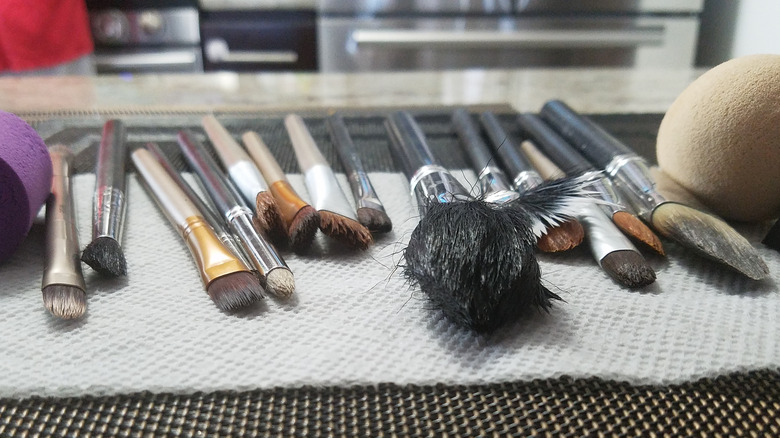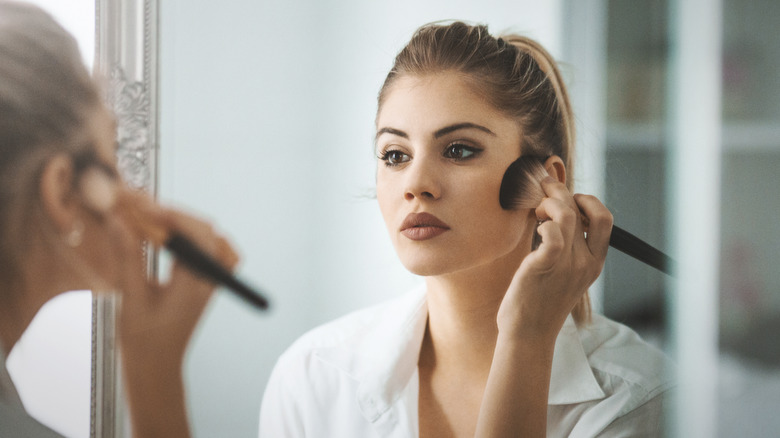The Major Concealer Application Mistake That's Ruining Your Look
You might think you know every trick in the book when it comes to applying your makeup perfectly, but if you've hit a few snags as of late, there could be a good reason for it. Whether you've been struggling with acne breakouts or just makeup clumping, it could be preventing you from creating a flawless look — and that can be disheartening in itself. If your issues seem to surround your concealer, you could be unknowingly making one simple mistake.
We're all guilty of having gone a little too long without cleaning our makeup brushes and tools at one point. As the American Academy of Dermatology Association (AAD) notes, there can be some major consequences of not cleaning these tools on a regular basis, including an increased risk of infection. On the less severe end of the spectrum, dirty makeup tools simply don't mix well with cosmetics, and that includes concealer. "I think so many of us are guilty of not washing our brushes as often as we should," professional makeup artist Mandie Brice told Shefinds. "Even applying with our fingers can be a mistake, if we don't first wash our hands ... this can lead to breakouts, or even infection."
If you aren't cleaning your makeup brushes and tools regularly, there's no better time to start than now, especially if you're running into issues with your concealer.
How to effectively clean your makeup brushes
As the AAD explains, regularly using makeup brushes and other tools on your face that are not routinely cleaned can result in an infection, such as E. coli or a staph infection. In these cases, you may need to see a doctor to receive proper treatment. Luckily, you can dramatically reduce the odds of this occurring by simply cleaning your makeup brushes every seven to 10 days, per the AAD. Best of all, keeping your tools clean can ensure that products — including concealer — go on smoothly.
To sufficiently clean your brushes, the AAD recommends rinsing them first under warm water to remove any lingering makeup. Then, fill a bowl with warm water and either a clarifying shampoo or similar product — anything harsher may dry out your makeup brush's bristles. Dunk the tips of each brush into the solution, thoroughly swirling it around until all residue appears to be gone. Finally, rinse every brush under water until it runs clear. To speed up the drying process, use a dry paper towel to sap up the extra moisture from the bristles. Allow your brushes to fully dry before giving them another go.
If your problems go beyond cakey concealer, however, you may want to contact your dermatologist. They can provide insight into why your makeup might be causing breakouts or other side effects on your skin and suggest treatment options.
Tips for flawless concealer application
Although it's undoubtedly a valuable makeup product to have on hand, concealer can be one of the trickiest cosmetics to apply. From choosing the wrong color to applying it incorrectly, concealer can end up being your face's worst enemy, if you aren't careful.
First, it's important to note that the concealer shade you should use will differ depending on where it is applied on your face. For example, the one you apply under your eyes should always have a peachy undertone to eliminate shades of purple that come with dark circles. Using this logic, the concealer shade you use to hide a blemish elsewhere on your face should more closely resemble your skintone in terms of warmth and coolness.
Next, many people mistakenly apply concealer prior to using their foundation — in actuality, it should be the other way around. Remember, your foundation serves as the "foundation" for the additional makeup you use, including your concealer.
Finally, don't forget about the importance of primer, as well as proper application. Primer can give your concealer a smooth surface to adhere to while extending its longevity. Keep in mind that after you apply your primer, you'll want to give it a few minutes to fully absorb and dry on your skin before using your concealer. Doing so can prevent caking and make sure that your concealer goes on easily.


